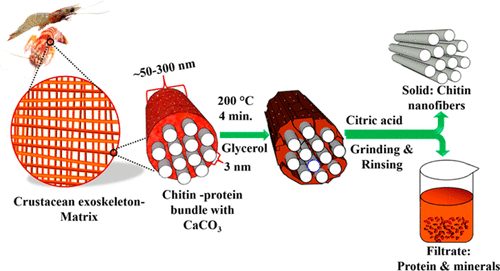当前位置:
X-MOL 学术
›
ACS Sustain. Chem. Eng.
›
论文详情
Our official English website, www.x-mol.net, welcomes your feedback! (Note: you will need to create a separate account there.)
Pretreatment in Hot Glycerol for Facile and Green Separation of Chitin from Prawn Shell Waste
ACS Sustainable Chemistry & Engineering ( IF 8.4 ) Pub Date : 2017-11-17 00:00:00 , DOI: 10.1021/acssuschemeng.7b03195 Ramamoorthy Devi 1 , Raghavachari Dhamodharan 1
ACS Sustainable Chemistry & Engineering ( IF 8.4 ) Pub Date : 2017-11-17 00:00:00 , DOI: 10.1021/acssuschemeng.7b03195 Ramamoorthy Devi 1 , Raghavachari Dhamodharan 1
Affiliation

|
A rapid and efficient process for the separation of chitin from waste prawn shells using hot glycerol pretreatment is reported. The pretreatment of waste prawn shell in hot glycerol enables the removal of protein possibly through dehydration and temperature induced fragmentation into low molecular weight water-soluble fragments, which are subsequently removed from the shell matrix by dissolution in water. In contrast, in the industrial process of preparing chitin from crustacean shells, the deproteinization is carried out with hot aqueous sodium hydroxide. The novel pretreatment present here should be applicable to all crustacean shell waste, in principle. Chitin was isolated by two different methods after the pretreatment in glycerol. In one of the methods, the pretreated shells were treated directly with citric acid to remove protein and minerals (mostly as calcium citrate). In the second method, the pretreated shells were ground and rinsed with water to remove protein fragments and part of the minerals (mostly as calcium carbonate). In the subsequent step, the residual minerals were demineralized with citric acid. The later method offers the additional advantage of removing a significant quantity of minerals without dissolution in the first step and also reduces the consumption of citric acid used in the demineralization step resulting in reduction in the emission of carbon dioxide. In addition, the glycerol can be used again for three successive cycles of treatment and beyond that can be recovered with charcoal treatment (90% recovery) and used again. The present method offers distinct advantages over the chemical method, such as lower residual protein (0.24%) and higher crystallinity index (80.9%) of chitin in addition to the separation of nanofibers of chitin. The recovery of byproducts, glycerol, and the simplicity of the present method guarantee that it could be a greener alternative to the chemical method, predominant in the current industrial scale production of chitin.
中文翻译:

在热甘油中进行预处理,以方便,绿色地分离虾壳废料中的甲壳素。
据报道,使用热甘油预处理可快速有效地从废虾壳中分离几丁质。在热甘油中对虾虾壳进行预处理,可以通过脱水和温度诱导的裂解将蛋白质去除成低分子量水溶性片段,然后通过溶解在水中将其从壳基质中除去。相反,在由甲壳类动物壳制备甲壳质的工业过程中,脱蛋白是用热的氢氧化钠水溶液进行的。原则上,此处提出的新型预处理应适用于所有甲壳类贝壳废料。在甘油中进行预处理后,通过两种不同的方法分离了几丁质。在其中一种方法中,预处理过的贝壳直接用柠檬酸处理以去除蛋白质和矿物质(大部分为柠檬酸钙)。在第二种方法中,将经过预处理的贝壳磨碎并用水冲洗以除去蛋白质碎片和部分矿物质(大部分为碳酸钙)。在随后的步骤中,将残留的矿物用柠檬酸脱矿。后一种方法的另一个优点是在第一步中无需溶解即可去除大量矿物质,并且还减少了脱盐步骤中柠檬酸的消耗,从而减少了二氧化碳的排放。此外,甘油可以连续三个处理周期再次使用,超过此值可以用木炭处理(回收率90%)回收并再次使用。本发明的方法与化学方法相比具有明显的优势,例如,除了分离几丁质的纳米纤维外,几丁质的残留蛋白含量较低(0.24%)和结晶度较高(80.9%)。副产物,甘油的回收以及本方法的简便性保证了它可以作为化学方法的更绿色替代品,这在当前几丁质的工业规模生产中占主导地位。
更新日期:2017-11-19
中文翻译:

在热甘油中进行预处理,以方便,绿色地分离虾壳废料中的甲壳素。
据报道,使用热甘油预处理可快速有效地从废虾壳中分离几丁质。在热甘油中对虾虾壳进行预处理,可以通过脱水和温度诱导的裂解将蛋白质去除成低分子量水溶性片段,然后通过溶解在水中将其从壳基质中除去。相反,在由甲壳类动物壳制备甲壳质的工业过程中,脱蛋白是用热的氢氧化钠水溶液进行的。原则上,此处提出的新型预处理应适用于所有甲壳类贝壳废料。在甘油中进行预处理后,通过两种不同的方法分离了几丁质。在其中一种方法中,预处理过的贝壳直接用柠檬酸处理以去除蛋白质和矿物质(大部分为柠檬酸钙)。在第二种方法中,将经过预处理的贝壳磨碎并用水冲洗以除去蛋白质碎片和部分矿物质(大部分为碳酸钙)。在随后的步骤中,将残留的矿物用柠檬酸脱矿。后一种方法的另一个优点是在第一步中无需溶解即可去除大量矿物质,并且还减少了脱盐步骤中柠檬酸的消耗,从而减少了二氧化碳的排放。此外,甘油可以连续三个处理周期再次使用,超过此值可以用木炭处理(回收率90%)回收并再次使用。本发明的方法与化学方法相比具有明显的优势,例如,除了分离几丁质的纳米纤维外,几丁质的残留蛋白含量较低(0.24%)和结晶度较高(80.9%)。副产物,甘油的回收以及本方法的简便性保证了它可以作为化学方法的更绿色替代品,这在当前几丁质的工业规模生产中占主导地位。


























 京公网安备 11010802027423号
京公网安备 11010802027423号